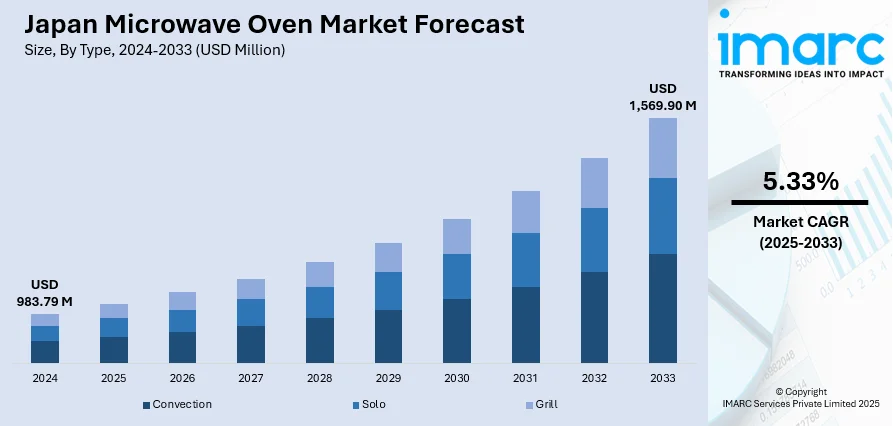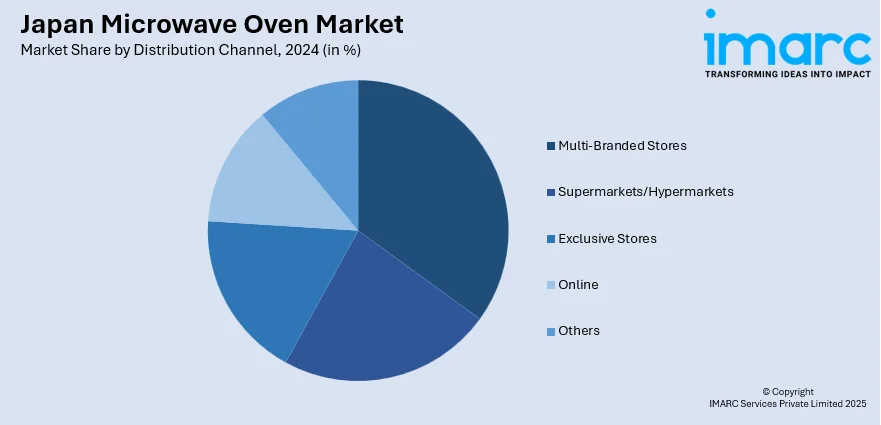
Japan Microwave Oven Market Size, Share, Trends and Forecast by Type, Capacity, Distribution Channel, End User, and Region, 2025-2033
Japan Microwave Oven Market Overview:
The Japan microwave oven market size reached USD 983.79 Million in 2024. Looking forward, IMARC Group expects the market to reach USD 1,569.90 Million by 2033, exhibiting a growth rate (CAGR) of 5.33% during 2025-2033. The market is being fueled by urbanization, small living areas, and cultural emphasis on efficiency and precision of cooking. Small kitchen spaces are found in most Japanese homes, and therefore, customers opt for compact, versatile appliances that have microwave, grill, and steaming capabilities. Japan's technologically advanced population also fuels the demand for smart ovens with sensor-controlled and voice-control capabilities. The presence of a robust domestic manufacturing base reinforces innovation and accessibility further supporting the steady expansion of the Japan microwave oven market share.
|
Report Attribute
|
Key Statistics
|
|---|---|
|
Base Year
|
2024
|
|
Forecast Years
|
2025-2033
|
|
Historical Years
|
2019-2024
|
| Market Size in 2024 | USD 983.79 Million |
| Market Forecast in 2033 | USD 1,569.90 Million |
| Market Growth Rate 2025-2033 | 5.33% |
Japan Microwave Oven Market Trends:
Small and Multifunction Microwave Ovens
Japan is witnessing the increasing prevalence of small and multifunction microwave ovens based on the desire to utilize limited living space in urban areas. Space optimization is a significant concern in Japanese households, especially those in Tokyo and Osaka, where kitchens are small. To solve this challenge, manufacturers have created microwave ovens that integrate several cooking capabilities, including grilling, baking, and steaming, into one compact device. Not only does this combine to save space, but it also provides convenience as users are able to carry out different cooking functions without having to use several appliances. Companies such as Panasonic and Sharp have been leading in the way with this, manufacturing models that suit the compact living conditions which are common in Japan. The success of these multifunctional appliances is symptomatic of a wider trend in Japanese consumer behavior, with the value placed on efficiency and space-saving solutions.

To get more information on this market, Request Sample
Health-Conscious Cooking Features
There is a trend among Japanese consumers to increasingly prioritize health-conscious cooking, which impacts the features incorporated into microwave ovens. There is an increasing need for appliances that provide cooking technologies like steaming and low-fat grilling, reflective of the conventional Japanese method of cooking that stresses health and nutrition. Microwave ovens with inverter technology and sensor cooking feature provide controlled temperature, so foods are cooked evenly, and nutrients are preserved. Some models even have specific settings for rice, a popular ingredient in Japanese cooking, to provide convenience and consistency. This emphasis on healthy cooking features demonstrates a cultural desire for good health and the need to preserve traditional eating habits despite the availability of modern cooking conveniences. Manufacturers are taking note of this trend and incorporating these features into their products as they respond to the changing tastes of Japanese consumers, which further contributes to the Japan microwave oven market growth.
Smart Technology Integration
The incorporation of smart technology into microwave ovens is a key trend in Japan as the nation adopts technological innovation within household appliances. Contemporary microwave ovens are now equipped with features such as Wi-Fi connectivity, voice recognition, and integration with smart home systems. For example, Panasonic's NN-SV79MS model comes with the option of controlling the appliance using voice commands through Alexa, offering a hassle-free and hands-free cooking experience. Such smart capabilities not only improve convenience but also appeal to the trend of increased interest in automation and connectivity in Japanese homes. Smart microwave ovens are especially attractive for tech-conscious consumers who want to connect their kitchen appliances into their larger smart home infrastructure. This trend indicates an evolution toward more intelligent and networked cooking solutions in Japan's microwave oven market.
Japan Microwave Oven Market Segmentation:
IMARC Group provides an analysis of the key trends in each segment of the market, along with forecasts at the country and regional levels for 2025-2033. Our report has categorized the market based on type, capacity, distribution channel, and end user.
Type Insights:
- Convection
- Solo
- Grill
The report has provided a detailed breakup and analysis of the market based on the type. This includes convection, solo, and grill.
Capacity Insights:
- Below 25 Liters
- 25-30 Liters
- Above 30 Liters
A detailed breakup and analysis of the market based on the capacity has also been provided in the report. This includes below 25 liters, 25-30 liters, and above 30 liters.
Distribution Channel Insights:

- Multi-Branded Stores
- Supermarkets/Hypermarkets
- Exclusive Stores
- Online
- Others
A detailed breakup and analysis of the market based on the distribution channel has also been provided in the report. This includes multi-branded stores, supermarkets/hypermarkets, exclusive stores, online, and others.
End User Insights:
- Residential
- Commercial
The report has provided a detailed breakup and analysis of the market based on the end user. This includes residential and commercial.
Regional Insights:
- Kanto Region
- Kansai/Kinki Region
- Central /Chubu Region
- Kyushu-Okinawa Region
- Tohoku Region
- Chugoku Region
- Hokkaido Region
- Shikoku Region
The report has also provided a comprehensive analysis of all the major regional markets, which include Kanto Region, Kansai/Kinki Region, Central /Chubu Region, Kyushu-Okinawa Region, Tohoku Region, Chugoku Region, Hokkaido Region, and Shikoku Region.
Competitive Landscape:
The market research report has also provided a comprehensive analysis of the competitive landscape. Competitive analysis such as market structure, key player positioning, top winning strategies, competitive dashboard, and company evaluation quadrant has been covered in the report. Also, detailed profiles of all major companies have been provided.
Japan Microwave Oven Market Report Coverage:
| Report Features | Details |
|---|---|
| Base Year of the Analysis | 2024 |
| Historical Period | 2019-2024 |
| Forecast Period | 2025-2033 |
| Units | Million USD |
| Scope of the Report |
Exploration of Historical Trends and Market Outlook, Industry Catalysts and Challenges, Segment-Wise Historical and Future Market Assessment:
|
| Types Covered | Convection, Solo, Grill |
| Capacities Covered | Below 25 Liters, 25-30 Liters, Above 30 Liters |
| Distribution Channels Covered | Multi-Branded Stores, Supermarkets/Hypermarkets, Exclusive Stores, Online, Others |
| End Users Covered | Residential, Commercial |
| Regions Covered | Kanto Region, Kansai/Kinki Region, Central /Chubu Region, Kyushu-Okinawa Region, Tohoku Region, Chugoku Region, Hokkaido Region, Shikoku Region |
| Customization Scope | 10% Free Customization |
| Post-Sale Analyst Support | 10-12 Weeks |
| Delivery Format | PDF and Excel through Email (We can also provide the editable version of the report in PPT/Word format on special request) |
Key Questions Answered in This Report:
- How has the Japan microwave oven market performed so far and how will it perform in the coming years?
- What is the breakup of the Japan microwave oven market on the basis of type?
- What is the breakup of the Japan microwave oven market on the basis of capacity?
- What is the breakup of the Japan microwave oven market on the basis of distribution channel?
- What is the breakup of the Japan microwave oven market on the basis of end user?
- What is the breakup of the Japan microwave oven market on the basis of region?
- What are the various stages in the value chain of the Japan microwave oven market?
- What are the key driving factors and challenges in the Japan microwave oven market?
- What is the structure of the Japan microwave oven market and who are the key players?
- What is the degree of competition in the Japan microwave oven market?
Key Benefits for Stakeholders:
- IMARC’s industry report offers a comprehensive quantitative analysis of various market segments, historical and current market trends, market forecasts, and dynamics of the Japan microwave oven market from 2019-2033.
- The research report provides the latest information on the market drivers, challenges, and opportunities in the Japan microwave oven market.
- Porter's five forces analysis assist stakeholders in assessing the impact of new entrants, competitive rivalry, supplier power, buyer power, and the threat of substitution. It helps stakeholders to analyze the level of competition within the Japan microwave oven industry and its attractiveness.
- Competitive landscape allows stakeholders to understand their competitive environment and provides an insight into the current positions of key players in the market.
Need more help?
- Speak to our experienced analysts for insights on the current market scenarios.
- Include additional segments and countries to customize the report as per your requirement.
- Gain an unparalleled competitive advantage in your domain by understanding how to utilize the report and positively impacting your operations and revenue.
- For further assistance, please connect with our analysts.
 Request Customization
Request Customization
 Speak to an Analyst
Speak to an Analyst
 Request Brochure
Request Brochure
 Inquire Before Buying
Inquire Before Buying




.webp)




.webp)












